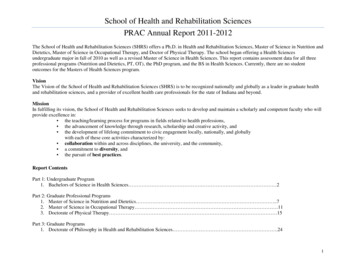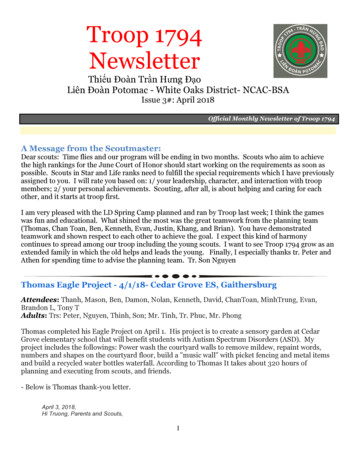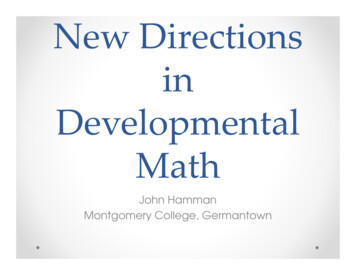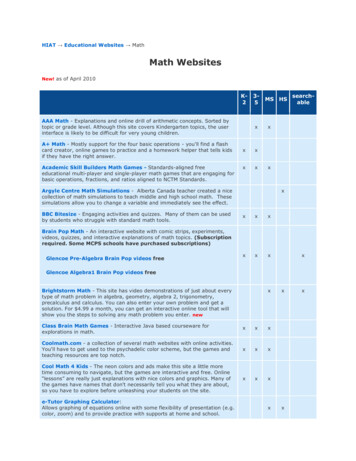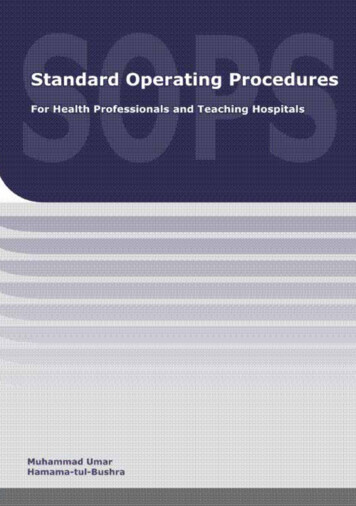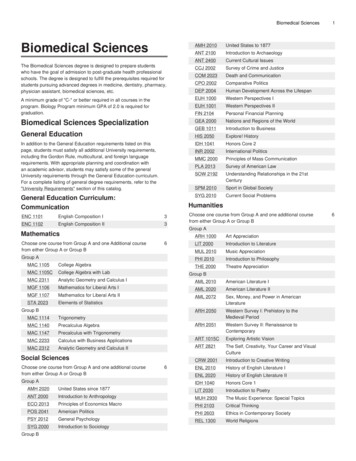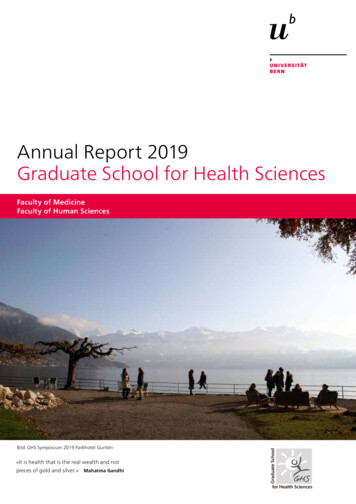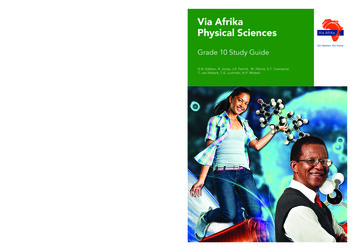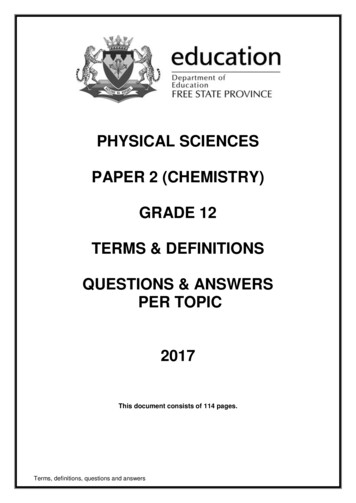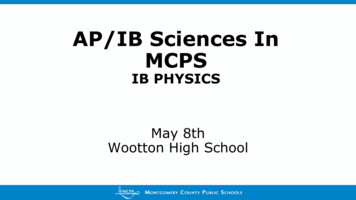
Transcription
AP/IB Sciences InMCPSIB PHYSICSMay 8thWootton High School
Matt Reese 11 years experience teaching IB Physics HigherLevel at Watkins Mill High School Member of the international team for the nextround of IB Physics Curriculum (was not on thisteam for the current curriculum) I grade IB Physics Internal Assessments andexams for IB.
Let's do somePhysics!Lenz’s Law
Learning Engagements: Overview of IB ProgramStandard Level vs. Higher LevelOverview of IB PhysicsExamine the pacing of the content in the courseInternal Assessments (IA)External Assessments
Diploma Program (DP)Grade 11-12The program aims to develop students who have excellent breadth and depth ofknowledge.DP students are required to take 6 IB courses as well as complete an Extended Essayand Theory of Knowledge.At least 3 of those courses must be Higher Level (HL)
Career-Related Program11-12 Grade The CP is a framework of international education addressing theneeds of students engaged in career-related education, or wantto specialize in one aspect of the DP program. Student must take at least 2 DP courses Designed for students who want to be in one of the countiesother programs (Project lead the way, Medical Careers, etc).
Standard Level (SL) vs. HigherLevel (HL) SL courses ensure students are exposed to a rangeof disciplines that they might otherwise opt out of. HL courses allow students to spend more time withsubjects they are more interested in by exploringoptions in addition to the SL core curriculum.
Standard Level vs. Higher LevelSL and HL courses consist of the same educationalaims, core syllabus curriculum and assessmentmodels. HL courses typically also include a range ofadditional elements designed to allow students toexplore areas of interest within the subject in moredepth. In this sense,
Standard Level vs. Higher LevelSL and HL courses consist of the same educationalaims, core syllabus and curriculum and assessmentmodels. HL courses typically also include a range ofadditional elements designed to allow students toexplore areas of interest within the subject in moredepth. In this sense, SL courses are not watered down versions of theirHL counterparts.
Standard Level vs. Higher LevelSL and HL courses consist of the same educational aims, coresyllabus and curriculum and assessment models. HL courses typically also include a range of additionalelements designed to allow students to explore areas ofinterest within the subject in more depth. In this sense, SL courses are not watered down versions of their HLcounterparts. The assessment criteria are equally demanding for both levels,and SL exams are marked and standardized with the samerigour as all IB coursework.
Overview of IB Physics 2 year course8 Core Topics (SL & HL)4 Additional Topics in HLOne “Option” Topic Internal Assessment (Lab Report) External Assessment (IB Exam)11
8 Core Topics - SL & HL1: Measurements and Uncertainties2: Mechanics (1st year college Physics)12
8 Core Topics - SL & HL3: Thermal Physics (2nd year)4: Waves (2nd or 3rd depending on the program)13
8 Core Topics - SL & HL5: Electricity and Magnetism (2nd year)6: Circular motion and gravitation (1st year)14
8 Core Topics - SL & HL7: Atomic, nuclear and particle physics (mix of2nd, 3rd or more advanced modern Physicscourse)8: Energy Production (connects the core materialto how power is generated, mixed in to othermaterial in college)15
Additional HL Material9: Wave Phenomena (focus on light and modernphysics, 3rd year college physics)10: Gravitational, Magnetic, and ElectromagneticFields (Mix between 1st & 2nd year collegePhysics)16
Additional HL Material11: Electromagnetic induction - How an electricgenerator works (2nd year and above collegePhysics)12:Quantum and Nuclear Physics (modernPhysics course)17
Options SL & HLA: Relativity - Popular option because it isengaging material.B: Engineering Physics - alligns course with APPhysics C.C. Imaging (Optics) - Fully aligns IB with SAT 2D. Astrophysics - Another popular option becausestudents find it interesting.18
Pacing 2 year course (4 semesters)Semester 1: Mechanics, Circular Motion, Gravity- aligns with typical 1st year college course.19
Pacing 2 year course (4 semesters)Semester 2: Thermal Physics, Electricity andMagnetism, Waves, Energy Production - alignswith typical 2nd year college course20
Pacing 2 year course (4 semesters)Semester 2: Thermal Physics, Electricity andMagnetism, Waves, Energy Production - alignswith typical 2nd year college courseFirst year of the course is aligned with typicaladvanced high school Physics courses & the SATII.21
Examine the pacing of thecontent in the courseSemester 3: Advanced Electricity and magnetism(topic 11), Atomic & Nuclear PhysicsSemester 4: Quantum Physics, Option ARelativity, Exam Review22
Internal Assessments (IA) Students will individually conduct aninvestigation about a Physics phenomena andwrite a detailed lab report. Worth 20% of the overall IB Physicsassessment grade.23
Sample IA24
Internal Assessments (IA) During year one schools complete practicereports during so students learn how to write areport. At the end of year 1 or start of year 2 studentsbegin their individual report25
External AssessmentsThree Part ExamPart I - Multiple Choice (1 hour)Part II - Written response (2:15)Part III - Data Analysis Questions and Option(1:15)26
Questions?Index Card:please include yourcontact infoOnline form:Type the link in your browseror scan the QR codebit.ly/SciNight19For more information on enrolling yourstudent in this course, please contact theCounselor and/or the Science DepartmentResource Teacher at your high school.
Semester 2: Thermal Physics, Electricity and Magnetism, Waves, Energy Production - aligns with typical 2nd year college course First year of the course is aligned with typical advanced high school Physics courses & the SAT II. 21. Examine the pacing of the content in the course Semester 3: Advanced Electricity and magnetism

